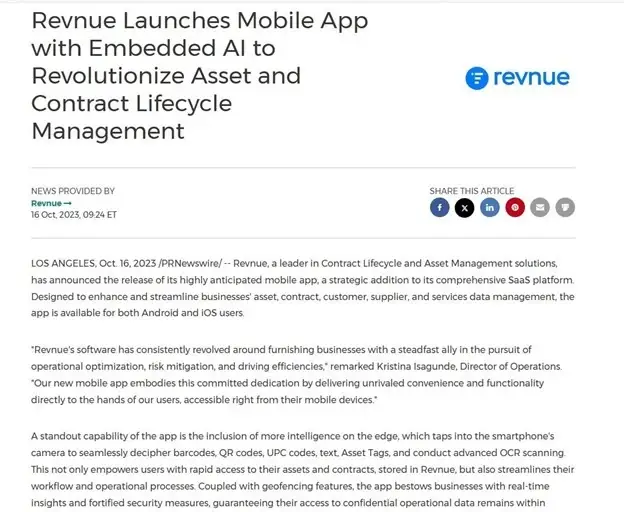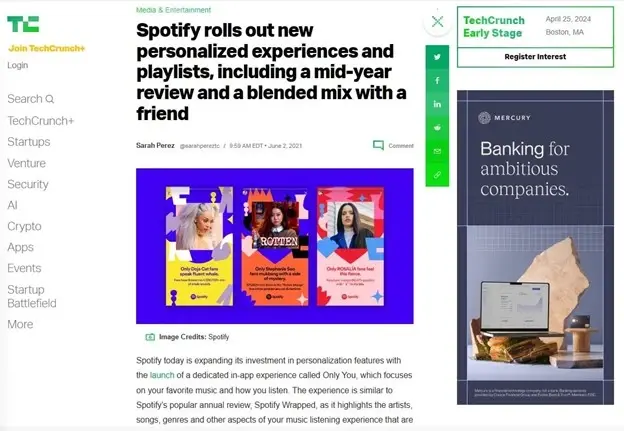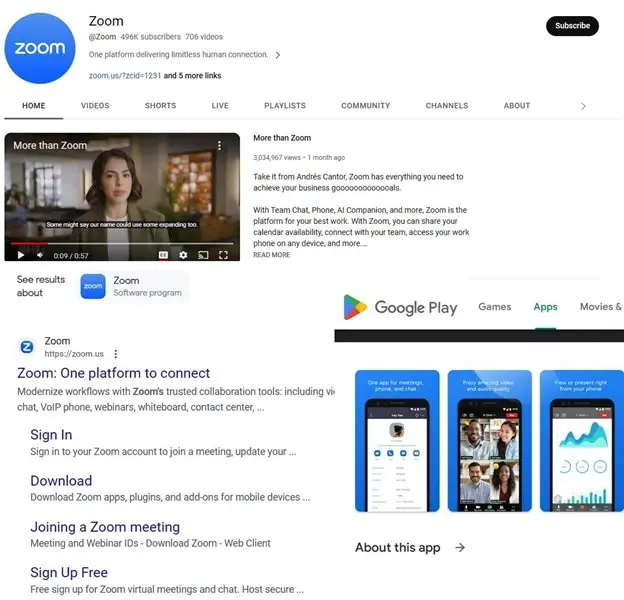9 Top Mobile App Marketing Trends of 2024 (+ Tips and Examples)
- Home
- Intelligent Insights Blog
- 9 Top Mobile App Marketing Trends of 2024 (+ Tips and Examples)
In today’s world, mobile devices are an extension of ourselves.
And it’s our mobile apps that keep us connected and entertained.
In the US alone, smartphone users spent 208 billion hours on mobile apps in 2022. The average user accesses 10 apps per day and 30 apps per month.
But with millions of available apps to choose from, marketing yours can present challenges.
How do you get users to download your app when there are others out there?
Attracting new users to download and install your app can be expensive and competitive. And even when users pick your app, keeping them engaged is another challenge.
But don’t be discouraged.
There are plenty of innovative strategies that can help bring your mobile app front and center.
That’s why we’ve outlined 9 of the top mobile app marketing trends for 2024. In addition, you’ll find tips and examples on how to use these trends to your advantage.
Not sure which of these trends would best benefit your mobile app strategy?
Let us help! Book a free consultation with one of our PR and marketing experts. We will take a look at your current strategy and see where it could benefit most from a refresh.
Our Mobile App Marketing Trends for 2024
- Public Relations
- Thought Leadership
- Influencer Marketing
- User Privacy
- Personalization
- Channel Diversification
- AI Tools
- Augmented Reality
- Geolocation Optimization
1. Public Relations Builds a Positive Image for Your Mobile App
When it comes to mobile app marketing, public relations (PR) serves as a well-timed push notification that grabs consumers’ attention.
That’s why PR is one of the top mobile app marketing trends. It generates buzz, builds trust, and helps you reach a wider audience.
To leverage PR, cultivate relationships with journalists and tech bloggers who cover topics related to your mobile app’s niche.
When pitching, use storytelling techniques to make your app and brand journey relatable and memorable. It helps to understand your audience’s preferences, the type of content they prefer, and their interests.
You might consider offering exclusive access to the app, interviews with the developers, or insights into its development process.
Only use press releases periodically when you want to update your audience on newsworthy milestones and new developments.
PR is one of the most successful mobile App marketing trends because it offers these three benefits:
- Enhanced Visibility: PR helps your app stand out in the crowded marketplace. It ensures that it receives the attention it deserves.
- Credibility and Trust: PR efforts establish credibility and trust among potential users. They leverage third-party endorsements and expert opinions, making your app more enticing and reliable.
- Effective User Acquisition: PR can lead to cost-effective user acquisition. Positive media exposure can attract a steady stream of new users, reducing the reliance on paid advertising for growth.
Here’s an example of a newsworthy press release for Revnue’s mobile app launch:

Pro Tip: The most important part of PR is crafting a compelling and unique narrative around your mobile app and brand. Highlight the problem it solves, its impact on users’ lives, or the innovation behind its development. Remember, not all PR has to be about your product.
Not sure how to write a press release for your mobile app? Then you’ll want to check out our dedicated guide: How to Write a Press Release for a New Mobile App
2. Thought Leadership Establishes Your Brand as an Industry Authority
Mobile app marketers often leverage thought leadership to establish the app developer or company as an authoritative voice within the industry.
Why?
Because thought leadership has a profound impact on consumers’ brand perceptions. That’s what makes it one of the top mobile app marketing trends for 2024.
To become a thought leader, offer unique, data-driven insights, industry trends, or solutions to common problems. Maintain a consistent presence by regularly publishing high-quality content. This can include blogs, whitepapers, and webinars.
Data storytelling can give your thought leadership some weight. But ensure your narrative is not overwhelmed by numbers. Instead, it should use data to support and enhance your message.
Select compelling data points that resonate with your audience and craft a clear, relatable story around them. This makes your insights more memorable and impactful.
Here are some more reasons why thought leadership is one of the top mobile app marketing trends:
- Credibility and Trust: When you position yourself as a thought leader, you gain the trust and respect of your audience.
- Educational Content: Thought leadership allows you to create valuable, educational content that demonstrates your expertise.
- Lead Generation: Thought leadership content can serve as a powerful lead generation tool. It can attract potential users who are interested in your app based on the knowledge and insights you provide.
The Forbes article below is an example of how to use thought leadership to promote your mobile app:

Pro Tip: Foster two-way communication with your audience through comments, Q&A sessions, or social media interactions. This engagement strengthens your thought leadership and builds a loyal user community around your app.
To learn how to harness the power of thought leadership, see our guide: Unlocking the Power of Thought Leadership Marketing (Benefits + Best Practices)
3. You Can Use Influencer Marketing to Spread the Word About Your App
Influencers play a significant role in consumers’ buying decisions. Mobile app brands adopt influencer marketing as one of their mobile app marketing trends because it increases reach and app downloads and engagement.
How can you adopt it into your marketing strategy?
Influencer marketing involves collaborating with social media influencers and content creators with a relevant following. Influencers create content that showcases your mobile app’s features, benefits, and use cases.
That might included:
- Sponsored Content
- Social Media Posts
- Reviews / Testimonials
- Demonstrations
- Tutorials
When working with influencers, select the ones whose interests and audience align with your app’s target demographic.
Encourage them to create authentic, engaging content that showcases how your app solves real problems or adds value to users’ lives.
Don’t underestimate the power of micro-influencers with smaller followings. They often have highly engaged audiences and can offer a cost-effective way to build awareness within your specific target market.
Here are a few reasons why you should make influencers one of your mobile app marketing trends:
- Expanded Reach: Collaborating with influencers helps extend your reach to a wider and more receptive audience.
- Credibility and Trust: Influencers, when well-matched with your app, can build credibility and trust. Their followers see their endorsements as authentic and reliable.
- Effective Content Creation: Influencers are experts at creating engaging content. They can effectively showcase your mobile app’s features and benefits in a way that resonates with their audience.
Want to learn how to leverage influencers? Check out our article: 9 Top Influencer Marketing Trends Shaping the Industry in 2024
4. User Privacy is More Important Than Ever
Mobile apps often collect personal information. As a result, users expect you to safeguard their data. Apps that mishandle user data risk a damaged reputation, which can lead to reduced user engagement and trust.
There is already a lack of trust when it comes to mobile apps and consumer data. In fact, many large tech companies have faced fines and other penalties for data breaches.
That’s why protecting user privacy is one of the top mobile app marketing trends for 2024.
To win the trust of app users, you will need to adopt bottom-up measurement methodologies. One popular one is SKAdNetwork 4.0. This allows you to safeguard user privacy and reduce user identification. Plus, it allows users to opt out of ad tracking.
Also, ensure your mobile app has a well-defined and easily accessible privacy policy. It should clearly explain what data you collect, how it’s used, and how users can opt out of data sharing.
This article from Stack Exchange shows how you can allow app users to opt out of data tracking:

Pro Tip: Implement robust security measures to protect user data, including encryption, access controls, and regular security audits. Ensure that any third-party services you use also follow stringent data protection practices.
5. Mobile App Consumers Prefer Personalization
Personalization is a great way to focus on long-term engagement, retention, and user loyalty. It involves tailoring content, recommendations, and user experiences within a mobile app. It aims to deliver relevant and customized content and interactions.
About 89% of marketers get positive results from using personalization. That’s why personalization isn’t just one of the top mobile app marketing trends, it’s one of the top digital marketing trends.
To leverage personalization, be sure to address obstacles in user journeys. Leverage customer engagement technology and first-party data. Prioritize user data privacy. Be transparent about how you collect and use their information.
Also, use detailed user segmentation to group users with similar characteristics, preferences, and behavior. This allows for more effective personalization efforts.
Here’s why personalization is one of the most relevant mobile app marketing trends:
- Enhanced User Engagement: Personalization increases user engagement by delivering tailored content, offers, and recommendations.
- Improved User Retention: Personalized experiences help retain users by catering to their individual preferences.
- Higher Conversion Rates: Personalized marketing messages and product recommendations can significantly boost conversion rates. They present users with relevant and enticing content.
Spotify’s personalized playlist is an example of how personalization and a robust recommender system works in mobile app marketing:

Pro Tip: Continuously test different personalization strategies to determine what works best for your audience. Use the results to refine and optimize your mobile app marketing campaigns.
Want to see a full list of general digital marketing trends for 2024? We’ve got you covered: 15 Digital Marketing Trends Worth Your Attention in 2024
6. Channel Diversification is a Must-Have
Channel diversification is another of our key mobile app marketing trends that allow you to build brand loyalty and retain users.
A cross-channel approach includes in-app and out-of-app communication.
To diversify your channels, ensure that your chosen marketing channels align with your app’s goals and target audience. Each channel should serve a specific purpose to maximize your results.
For example, you can use one channel for user acquisition, while you use another for engagement and retention.
Also, tailor your content to suit the nuances and requirements of each channel. Adapting your content ensures that it resonates with the audience on that particular channel.
These are the key reasons why channel diversification is one of the top mobile app marketing trends:
- Expanded Presence: Channel diversification expands your mobile app’s presence. This allows you to reach a broader and more diverse audience.
- Risk Mitigation: Relying on a single marketing channel can be risky. Diversification spreads the risk and reduces the impact of changes or disruptions in any one channel.
- Enhanced User Experience: You can enable your audience to engage with your app through their preferred platforms and communication methods.
Below, you’ll find an example of what channel diversification in mobile app marketing looks like.
This example for Zoom shows that the app has channels on Facebook, Google Play, and Google search results:

Pro Tip: Continuously monitor and analyze the performance of channels to identify which are delivering the best results. Use your insights to optimize your strategy by reallocating resources and efforts to the most effective channels. You can also improve the underperforming one.
7. AI Tools Can Handle Multiple Mobile App Marketing Functions
Apps that are powered by artificial intelligence (AI) are becoming increasingly popular. AI enhances various aspects of mobile app marketing. Plus, you can use it in a variety of ways, from predictive analytics to fraud detection.
That’s what makes AI one of the most important mobile app marketing trends you can adopt.
But what does it look like in action?
First, consider using AI algorithms or AI-powered tools to segment your user base based on behavior, preferences, and demographics. You can use the data you collect to inform your personalization and content marketing efforts across channels.
Next, consider integrating chatbots or virtual assistants into your app. These can provide real-time customer support, answer user queries, and guide users through your app.
Just be sure to tailor AI responses to align with your brand’s tone and style. This helps ensure a consistent user experience.
Here are some top reasons why AI is one of the most innovative mobile app marketing trends:
- Personalized Customer Interactions: AI can provide personalized and real-time responses to user inquiries. This enhances user engagement and satisfaction within your mobile app.
- Efficient Customer Support: AI can handle routine customer support queries 24/7. This reduces response times.
- Data Insights: You can analyze interactions with AI to gain valuable insights into user preferences, pain points, and frequently asked questions. This enables data-driven improvements to your mobile app and marketing strategies.
Here is an example of how AI is used in mobile app marketing:
Pro Tip: Regularly update and train AI tools to stay current with your app’s features, promotions, and user queries. This way, AI remains relevant and informative.
You can use AI to automate a lot of general marketing tasks as well. Want to learn more? Read here: 10 Emerging Marketing Automation Trends for 2024
8. Augmented Reality (AR) Provides an Immersive Experience for App Users
Marketers are increasingly adopting AR as one of their mobile app marketing trends because it helps them create interactive and engaging experiences.
In fact, the number of mobile AR users around the world has grown over the last few years.
As a result, many mobile app marketers use AR to promote products or services and drive user acquisition. So, what should you keep in mind when using it?
Ensure that the AR experience is intuitive and user-friendly. Users should be able to easily access and interact with AR features within your app.
Marketing an AR feature within your app is crucial. Educate users about how to access and use AR content through tutorials, in-app guides, and promotional materials.
Also, use social media, email marketing, and other channels to generate excitement and anticipation for your AR features.
What makes AR one of the top mobile app marketing trends? Here are a few of its key benefits:
- Innovative User Experiences: AR enhances user engagement by offering immersive and interactive experiences.
- Improved Product Visualization: AR allows users to visualize products in real-world settings.
- Differentiation and Brand Recognition: Integrating AR into your mobile app marketing sets you apart from competitors.
Here is an example from Wayfair that demonstrates how app marketers use augmented reality:

Pro Tip: Create AR content that offers real value to users. For example, if you’re in e-commerce, allow users to virtually try on products. If you’re in tourism, provide AR tours or location-based information. AR should enhance users’ understanding or decision-making.
9. App Marketers Can Leverage Geolocation Optimization
Today, about 90% of mobile apps have geo-tracking capabilities. Geolocation optimization involves leveraging a user’s geographic location data.
Why is it one of the top mobile app marketing trends?
Because it helps enhance the effectiveness of the marketing strategies within your mobile app. Geolocation optimization is beneficial for both user engagement and personalization.
Mobile apps can use a user’s real-time or historical location data to deliver highly targeted marketing messages. For example, a retail app can send a notification about a special promotion when a user is near a physical store.
To make this part of your mobile app marketing efforts, ensure it’s relevant to users’ locations and situations. For example, if a user is near a shopping mall, send them a promotion for a nearby store or restaurant.
Ensure the accuracy and quality of location data. Inaccurate data can result in misguided marketing efforts. Use reliable geolocation services and technologies to collect and interpret user location data. Regularly verify the data for accuracy and consistency.
These are a few key reasons why geolocation optimization is one of the leading mobile app marketing trends:
- Local Search and Discovery: Apps can use geolocation to help users discover nearby businesses, services, or points of interest. For example, a restaurant app can provide users with a list of nearby restaurants or coffee shops.
- Location-based Offers: Mobile apps can offer exclusive deals or discounts to users based on their proximity to a particular location. This encourages users to visit physical locations, such as retail stores or restaurants.
- Location-based Content: Content within the app can include news, events, or recommendations based on a user’s location.
The example below shows how app marketers leverage geolocation optimization:

Pro Tip: Prioritize user privacy and obtain explicit consent to access their location data. Offer users clear information about how you will use their location data. Also, discuss the benefits they’ll receive in return.
Key Takeaways on the Latest Mobile App Marketing Trends
Mobile apps are an integral part of modern life. They reflect our interests and connect us to the digital world. Using innovative marketing strategies is important for your app’s success. However, marketing mobile apps is challenging due to the competitive marketplace.
Acquiring new users and keeping them engaged is an ongoing struggle. Making your app stand out will require innovative marketing strategies. These include personalization, ethical data usage, multi-channel marketing, and much more.
These mobile app marketing trends also emphasize the need for user-centric approaches. Exploring these trends, along with tips and examples, can provide you with valuable insights into how to effectively market your mobile app and adapt to emerging consumer demands.
Still now sure which of these mobile app marketing trends will work best for you? Let us help! Simply book a free consultation to get expert insight into how to best boost your strategy.

